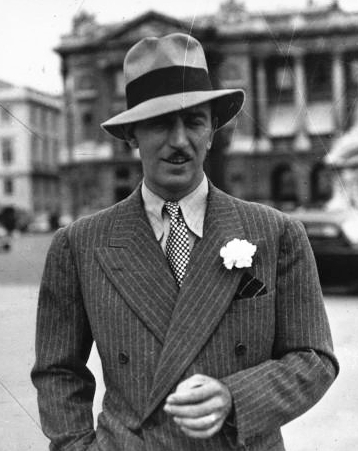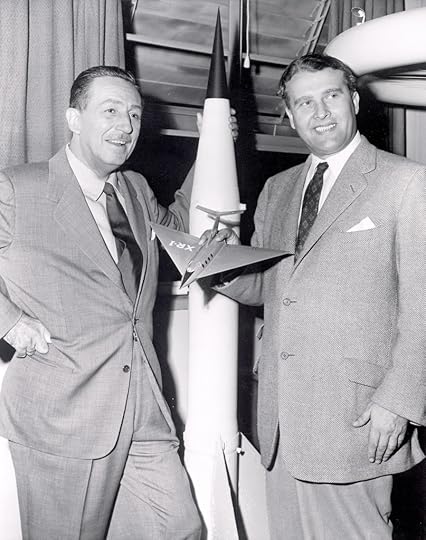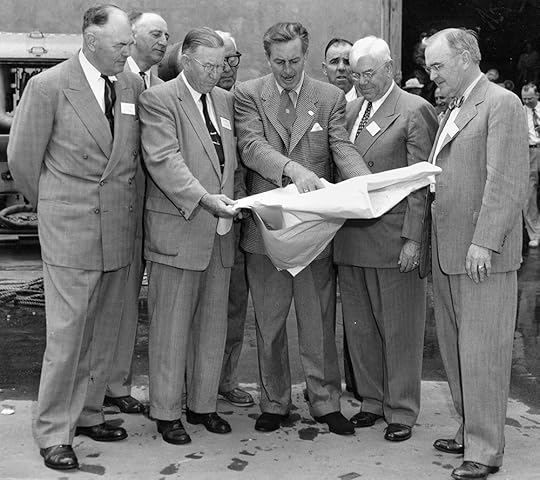Ripley Entertainment Inc.'s Blog, page 293
January 25, 2019
CARTOON 01-25-2019
January 24, 2019
Could Walt Disney Really Be Cryogenically Frozen?
Featured in Ripley's Believe It or Not!

Walt Disney dedicated his life to the creation of children’s entertainment and became such an important part of American history that his name still lives on today in the films, parks, and the ample merchandise that bear it. Still, Disney was known to be quite secretive, which is part of the reason why rumors still persist about his life and death, the most famous one being that his body—or perhaps just his head—was cryogenically frozen and buried in an undisclosed location so he could live again in the future.
Is the Walt-cicle Rumor True?
While Walt Disney was a strange man who was definitely interested in the future and potentially preoccupied with his own demise, there is no clear evidence to back up the claim that he is frozen and buried in any kind of undisclosed location (the most popular rumor being under Pirates of the Caribbean ride at Disneyland in Anaheim, California). Still, many people continue to believe this far-out claim for a number of reasons.

Disney’s Death and the Rumor Mill
Walt Disney died on December 15, 1966 of complications related to the surgery he had undergone for lung cancer. The funeral, which occurred on December 16, was only attended by family and was very small and private. This makes sense, however, as Disney stated while alive that he specifically avoided going to funerals whenever he could help it and didn’t want a funeral of his own.
In addition, many people believe that the exact location of Disney’s plot has not been released to the public. This is untrue as well, as Disney’s plot is a matter of public record, although, because he was a celebrity, the location isn’t given out freely by the officials at his burial site.
Who Said Disney Wanted to Be Frozen?
This is all perfectly understandable, so why are we so convinced that Disney wanted to be—or was—frozen? One reason is because of two biographies that were written about Disney after his death: 1986’s Disney’s World by Leonard Mosely and 1993’s Walt Disney—Hollywood’s Dark Prince by Marc Eliot. Both of these works cited Disney’s interest in cryogenics but have since been widely discredited for their speculative nature and lack of citation.

Walt Disney with aerospace engineer Wernher Von Braun.
Another reason is because cryogenics were just beginning to hit the radars of average Americans around the time of Disney’s death. The magazine Ici Paris actually published the rumor in 1969, stating that it had come from a group of animators who had been enjoying a private joke that somehow went public.
In addition, Bob Nelson, the president of the California Cryogenics Society, gave an interview in 1972, saying that Disney wasn’t frozen but that he had wanted to be. “The truth is, Walt missed out. He never specified it in writing, and when he died the family didn’t go for it. They had him cremated. I personally have seen his ashes. They’re in Forest Lawn. Two weeks later we froze the first man.” Nelson, who was a TV repairman before becoming president of the society the same year Disney died, likely said these things in an attempt to grab attention for his business without making a statement that could be completely discredited.
Disney’s Unfrozen Legacy
Frozen or not, Disney certainly lives on through his company and stories. Still, there is almost no evidence to the idea that the animator is being kept on ice and buried anywhere, let alone under one of his parks.

Walt Disney discussing park plans with Orange County leaders.
By Julia Tilford, contributor for Ripleys.com
CARTOON 01-24-2019
January 23, 2019
Intense Feats At The Phuket Vegetarian Festival
Featured in Ripley's Believe It or Not!

Each October in Thailand, the town of Phuket transforms to become an epicenter of zealous excitement and fervor. The Vegetarian Festival is celebrated in different ways throughout Asia and is meant to mark the return of the nine emperor gods. People attend vigils at shrines and abstain from meat for about a week in order to purify themselves for good health and prosperity in the coming year.
While these celebrations are grand throughout the areas they are celebrated, Phuket is renowned for its unique interpretation. Along with the traditional foods, prayers, and incense burning; self-mutilation is a mainstay.

Devotees have needles pierced through their arms, legs, back and even their face as a way of bringing good luck to themselves and the community. This ritualized mutilation is performed while the recipient is placed in a trance-like state.
According to priests, it is the power of the gods that allows them to endure the excruciating pain with little ill effects on their body. Indeed, it seems a miracle that these demonstrators can inflict great harm upon themselves at the outset of the festival, but walk away without even the need for bandages at the end.
People who engage in these acts of self-mutilation are often veterans of the art, but not professionals. They don’t perform these stunts throughout the year and are just ordinary people.
These feats are done completely without anesthetic or painkillers—things prohibited during this time of purity. Instead, they are coached by other performers who ensure the use of sterilized gloves and needles. During the festival, it’s common for the self-flagellators and piercing-fanatics to care for each other’s injuries.

CARTOON 01-23-2019
January 22, 2019
Locket Containing George And Martha Washington’s Intertwined Hair
Featured in Ripley's Believe It or Not!

Though it may be considered macabre by modern standards, taking the hair of the dead as a memento mori was common throughout the 16th and 17th centuries. Sealed between two pieces of glass, the locket here contains the intertwined hair of America’s first constitutional president, George Washington, and his wife, Martha.
Contrary to popular belief, Washington never wore a wig, but was renowned for using his natural hair to command people’s respect and attention. While his hairstyle may look formal now, back in the 1700s, the pigtail-poof look he’s depicted as wearing was seen as a distinctly military cut—similar to today’s Marine buzz-cut. Washington wore this hairstyle specifically to project ineffable manliness. To him, wigs were better left to socialites like John Adams, Thomas Jefferson, and James Monroe. Called a queue, Washington’s ponytail pulled his forehead back, a symbol of force and power in those days.

Despite his macho appeal, Washington was still attentive to his looks. Military uniforms with aligned buttons and chalked, greased, hair completed his countenance of authority that appears in every depiction—whether it’s crossing the Delaware or adorning the quarter.
More Than Just Hair
While Washington’s hair is one fascinating part of the brooch, the artifact also represents the love between America’s first president and first, first lady.
Washington married Martha in the winter of 1759. She brought two children from her first marriage, whom Washington helped raise despite never having children of his own. According to Marquis de Lafayette, Martha was madly in love with Washington, sometimes traveling thousands of miles to see him in the most bitter and inhospitable conditions of the war.

Despite containing both George and Martha Washington’s hair, this brooch did not belong to them. It was entrusted to Washington’s secretary—and very close friend—Tobias Lear.
Friend and Confidant
Despite his close connection with Washington late in life, Lear didn’t participate in the Revolutionary War. Instead, he met the Washingtons through tutoring their children, quickly integrating himself into the Washingtons’ complex estate. Rising from being Washington’s clerk to his right-hand man, the two grew close, as Lear was involved in the president’s daily life and shared most meals with him.

During Washington’s second term, Lear convinced the president to go into business with him. Failing, this snowballed into a string of tragedies for Lear. For example, he lost his wife in a yellow fever epidemic, remarried and lost his second wife three years later to tuberculosis.
In the midst of these tragedies, Lear continued to perform unpaid errands for Washington. Under the pressure of his own collapsing finances, he pocketed a rent payment he was sent to collect. Washington was furious when he found out, but soon forgave him and offered up a position in the army. Despite never seeing active duty, Lear seemed to feel closer to Washington with the rank of colonel. He served as Washington’s chief aide until the president retired.
When Washington fell ill in 1799, Lear was present at Mount Vernon. Washington’s last words to his old friend were instructions that he be simply buried. Despite a presidential tomb constructed underneath the capitol building, Lear made sure to oversee all of the funeral arrangements himself, ensuring Washington was laid to rest at Mount Vernon.
About ten o’clk, Saturday December 14, 1799, Washington made several attempts to speak to me before he could effect it, at length he said,—”I am just going. Have me decently buried; and do not let my body be put into the Vault in less than two days after I am dead.” I bowed assent. He then looked at me again and said, “Do you understand me?” I replied “Yes.” “‘Tis well” said he. —From Lear’s diary

After the president’s death, Lear was given a brooch containing Washington and Martha’s hair. The hair sits behind beveled glass, is flanked with rubies, and is inscribed with “gage de mon amitie,” meaning “token of my friendship,” in French.

Source: Locket Containing George And Martha Washington’s Intertwined Hair
CARTOON 01-22-2019
January 21, 2019
The Mystery of Kodinhi: India’s Town Of Twins
Featured in Ripley's Believe It or Not!

There are some places in the world that just take everything science thinks it knows and shreds that rule-book to pieces. One such place is a small, unprepossessing village in India, which boasts a birth-rate of twins so high it borders on the impossible!
On the surface, there’s nothing remarkable about Kodinhi, a modest settlement in Kerala, India. It’s home to around 2,000 families, but the remarkable thing is that there are at least 400 pairs of twins in those families!
Twins, Twins Everywhere
As a country, India has one of the world’s lowest rates for pairs of twins born. The average is no higher than 9 per 1,000 births, but the people of Kodinhi certainly don’t seem to have gotten that memo. There, the rate is estimated to be around 45 per 1,000 births! This is one of the highest anywhere in the world. Clearly, something doesn’t quite add up here.
What’s the explanation for this one, then, science?
In short, there really isn’t one. Not that scientists haven’t tried. In the late 2000s, The Daily Mail reports, local doctor Krishnan Sribiju took a look into the case. He said at the time, “Indian, and by that I mean Asian, people on the sub-continent have the lowest acknowledged incidences of twinning in the world at around four per thousand.”
“In addition, there is no IVF treatment here because of the prohibitive cost. Global rates of twins being born, especially in the western world, have increased because of artificial insemination.”
Another general factor in heightened rates of twinning, he continued, is that they tended to be born to more mature women, who were over 5ft 3in tall. Again, though, the people of Kodinhi weren’t about to fit into that neat little pigeonhole. As a rule, they marry in their late teens and begin families soon after. In addition to that, the women of the village average around 5ft in height.
Where Are They All Coming From?
Other possible explanations have included the diet of the people of Kodinhi. It doesn’t appear that there’s anything in the water (or the food), though, as there’s nothing out of the ordinary in their diet compared to other communities in the area. Yet another logical dead end. All Sribiju could conclude was, “To the best of my knowledge this medical marvel began somewhere between 60 to 70 years ago.”
What is it about this village and others like it? What began a few generations ago? It’s even tough to say whether it’s connected to the people themselves or the area where they live. There are reports that women who have married people from Kodinhi and moved there have also exhibited a high rate of twin births, as have those who have moved away and started families elsewhere!

Researchers continue to conduct genetic studies of the twins of Kodinhi, hoping to find some sort of answer. As of yet, we don’t know anything definitive, or even if we ever will. There are some things science just cannot explain, however hard it tries.
A Worldwide Mystery
Another interesting factor to the tale is that India’s Kodinhi is not the only Twin Town in the world. Far from it, in fact.
In 2016, it was reported that a research team had arrived in Kodinhi. The goal of their investigation was to compare certain genetic factors of Kodinhi’s residents with those of parts of Vietnam, Nigeria and Brazil, where there are also similar communities (Hung Loc Commune, Igbo-Ora and Candido Godo respectively).
One member of the study, Dr. Thirumalaswami Velavan of Tuebingen University, said that the research “would identify genetic factors determining the hereditability of twins. There is no known genetic link identified yet for identical twinning and the real factor behind the phenomenon is yet to be ascertained”
“The outcome of the study shall lay a basis to understand the underlying genetic and epigenetic factors that may hold key answers for the high twinning rate in Kodinhi.”
As yet, we really don’t have any of these key answers. The mystery of Kodinhi will remain a mystery for now, but it’s one that’s always worth trying to tackle. After all, it’s possible that communities such as these could contribute to our understanding of genetics and fertility; perhaps in time offering some salvation for infertile couples.
In the meantime, the people of Kodinhi continue to delight in their newfound fame and mysterious village. It’s the birthplace of TAKA, the Twins and Kins Association, an organization that has made it their goal to educate and help those who bore Twin Town’s impossible twins.
By Chris Littlechild, contributor for Ripleys.com
CARTOON 01-21-2019
January 20, 2019
CARTOON 01-20-2019
Ripley Entertainment Inc.'s Blog
- Ripley Entertainment Inc.'s profile
- 52 followers









